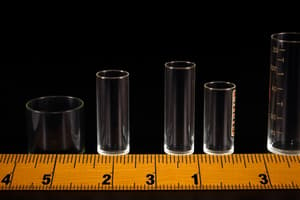Podcast
Questions and Answers
What is the primary reason the International System of Units (SI) is crucial in scientific, medical, and technological fields?
What is the primary reason the International System of Units (SI) is crucial in scientific, medical, and technological fields?
- It provides a consistent and standardized way of measuring quantities. (correct)
- It simplifies complex calculations by using fewer units.
- It allows for easier conversion to other unit systems.
- It is easier to learn compared to other measurement systems.
Which of the following is NOT one of the seven fundamental SI units?
Which of the following is NOT one of the seven fundamental SI units?
- Kilogram (kg)
- Ampere (A)
- Mole (mol)
- Celsius (°C) (correct)
How does the use of SI units contribute to patient safety in medication administration?
How does the use of SI units contribute to patient safety in medication administration?
- SI units ensure accurate dosage prescriptions, reducing the risk of errors. (correct)
- SI units are only used for medications with high risk factors.
- SI units eliminate the need for complex calculations.
- SI units are easier for patients to understand.
In what way does the adoption of SI units globally impact medical research and clinical practices?
In what way does the adoption of SI units globally impact medical research and clinical practices?
What is the significance of expressing radiation doses in Gray (Gy) or Sieverts (Sv)?
What is the significance of expressing radiation doses in Gray (Gy) or Sieverts (Sv)?
While Kelvin (K) is the SI unit for temperature, which unit is commonly used in medical practice?
While Kelvin (K) is the SI unit for temperature, which unit is commonly used in medical practice?
Why is measuring blood pressure in millimeters of mercury (mmHg) still prevalent, despite Pascal (Pa) being the SI unit for pressure?
Why is measuring blood pressure in millimeters of mercury (mmHg) still prevalent, despite Pascal (Pa) being the SI unit for pressure?
How does the standardization of units affect the conversion of medication dosages between countries?
How does the standardization of units affect the conversion of medication dosages between countries?
What is the rationale behind healthcare organizations complying with international standards for measurement?
What is the rationale behind healthcare organizations complying with international standards for measurement?
In radiology, if a patient receives a dose of radiation, which units are used to measure the absorbed dose and biological effect, respectively?
In radiology, if a patient receives a dose of radiation, which units are used to measure the absorbed dose and biological effect, respectively?
What is the primary advantage of using SI units in the measurement of substances' concentration in blood?
What is the primary advantage of using SI units in the measurement of substances' concentration in blood?
How do standardized SI units impact the accuracy of medication dosage calculations based on a patient's weight?
How do standardized SI units impact the accuracy of medication dosage calculations based on a patient's weight?
Why is it essential to maintain strict limits on X-ray doses and other forms of medical imaging?
Why is it essential to maintain strict limits on X-ray doses and other forms of medical imaging?
What is the implication of measuring oxygen saturation relative to the partial pressures of gases in the blood, using the SI unit of pressure (Pascal, Pa)?
What is the implication of measuring oxygen saturation relative to the partial pressures of gases in the blood, using the SI unit of pressure (Pascal, Pa)?
Given that 'International Standardization' is listed as an advantage of using SI units, what is the direct benefit of this in medical contexts?
Given that 'International Standardization' is listed as an advantage of using SI units, what is the direct benefit of this in medical contexts?
How is ambiguity reduced by using a single, standardized system of units like SI in medicine?
How is ambiguity reduced by using a single, standardized system of units like SI in medicine?
Which of the following is NOT a direct benefit of 'Improved Patient Outcomes' through consistent measurement using SI units?
Which of the following is NOT a direct benefit of 'Improved Patient Outcomes' through consistent measurement using SI units?
What is the MOST direct outcome of 'Regulatory Compliance' in healthcare organizations adhering to international standards for measurement, particularly using SI units?
What is the MOST direct outcome of 'Regulatory Compliance' in healthcare organizations adhering to international standards for measurement, particularly using SI units?
If a doctor prescribes a medication in milligrams (mg), micrograms (µg), or milliliters (mL), what primary goal is achieved by using precise SI units for the drug dosages?
If a doctor prescribes a medication in milligrams (mg), micrograms (µg), or milliliters (mL), what primary goal is achieved by using precise SI units for the drug dosages?
Why is mass typically measured in kilograms (kg) rather than moles (mol) in clinical settings?
Why is mass typically measured in kilograms (kg) rather than moles (mol) in clinical settings?
Flashcards
International System of Units (SI)
International System of Units (SI)
A globally accepted system of measurement established in 1960, based on seven fundamental units.
Seven Fundamental SI Units
Seven Fundamental SI Units
Meter (m) for length, Kilogram (kg) for mass, Second (s) for time, Ampere (A) for electric current, Kelvin (K) for temperature, Mole (mol) for amount of substance, Candela (cd) for luminous intensity.
Accuracy via SI Units
Accuracy via SI Units
Ensures measurements are precise, reducing errors in dosages, blood pressure readings, and other critical health parameters.
Consistency of SI Units
Consistency of SI Units
Signup and view all the flashcards
SI Units in Drug Dosages
SI Units in Drug Dosages
Signup and view all the flashcards
SI Units in Radiology
SI Units in Radiology
Signup and view all the flashcards
SI Unit for Temperature
SI Unit for Temperature
Signup and view all the flashcards
SI Units for Blood Pressure
SI Units for Blood Pressure
Signup and view all the flashcards
Reduced Ambiguity
Reduced Ambiguity
Signup and view all the flashcards
Improved Patient Outcomes
Improved Patient Outcomes
Signup and view all the flashcards
Regulatory Compliance
Regulatory Compliance
Signup and view all the flashcards
Safety
Safety
Signup and view all the flashcards
SI unit for mass
SI unit for mass
Signup and view all the flashcards
Dosage Calculation
Dosage Calculation
Signup and view all the flashcards
Concentration of Blood Substances
Concentration of Blood Substances
Signup and view all the flashcards
Study Notes
Introduction to SI Units
- The International System of Units (SI) is a globally accepted measurement system established in 1960.
- It consists of seven fundamental units from which all other units are derived.
- Offers a consistent and standardized approach to measuring quantities.
- Crucial for scientific, medical, and technological advancements.
Seven Fundamental SI Units
- Meter (m) is the SI unit for length.
- Kilogram (kg) is the SI unit for mass.
- Second (s) is the SI unit for time.
- Ampere (A) is the SI unit for electric current.
- Kelvin (K) is the SI unit for temperature.
- Mole (mol) is the SI unit for the amount of a substance.
- Candela (cd) is the SI unit for luminous intensity.
- Standardized units in medicine ensure consistent, accurate, and universally understood measurements and calculations.
Importance of SI Units in Medicine
- Medical practice depends on precise measurements for diagnosis, treatment, and monitoring.
- Accuracy is ensured through SI units where medical professionals rely on measurements for drug dosages, blood pressure, and temperature.
- Consistency is achieved because SI units are standardized globally, enabling consistency in medical research and clinical practices.
- SI units ensure safety by giving accurate medication dosages.
- Standardized units prevent overdoses and underdoses.
- Global communication is made possible due to health professionals using SI units to effectively communicate medical data worldwide.
- Radiation doses are expressed in gray (Gy) or sieverts (Sv).
Key Applications of SI Units in Medicine
- Kelvin (K) is the SI unit for body temperature, though Celsius (°C) is the common unit used in practice, with a normal body temperature of 37°C.
- Fever is defined as a body temperature over 38°C, and temperatures exceeding 40°C can be dangerous.
- Millimeters of mercury (mmHg) is the unit for blood pressure, which is derived from the SI unit of pressure Pascal (Pa).
- 120/80 mmHg is a typical blood pressure reading
- Kilogram (kg) is the SI unit for mass.
- Patient weight is often measured in kilograms in clinical practice.
- Dosage calculations are based on weight, and standardized units ensure correct prescriptions.
- Medications are prescribed in milligrams (mg), micrograms (µg), or milliliters (mL).
- Correct SI units for drug dosages prevent harmful errors where a 5 mg dosage ensures patient receives the correct amount.
- Gray (Gy) measures absorbed dose, and sievert (Sv) measures the biological effect of radiation.
- Standardized measurements are a requirement for X-ray doses and medical imaging.
Oxygen Saturation and Concentration of Substances in Blood
- Oxygen saturation is measured in percent (%), which is related to partial pressures of gases (Pa) in the blood, based on Pascal (Pa).
- Moles per liter (mol/L) is the SI unit of concentration, but is expressed as millimoles per liter (mmol/L) for interpretation.
Advantages of Using SI Units in Medicine
- International standardization allows for easier sharing and comparison of medical data across countries.
- Reduced ambiguity comes from using a single, standardized system.
- Improved patient outcomes are a result of consistent measurements that minimize errors in dosage calculation and monitoring of patient progress.
- Regulatory compliance with international measurement standards ensures efficacy and safety of treatments.
Studying That Suits You
Use AI to generate personalized quizzes and flashcards to suit your learning preferences.



